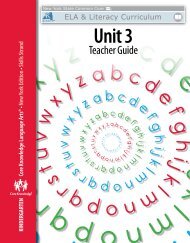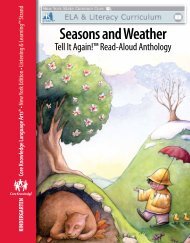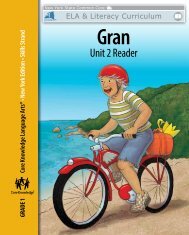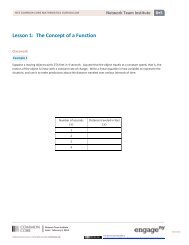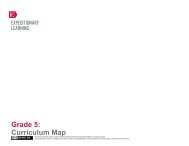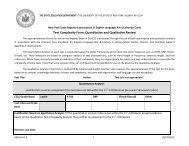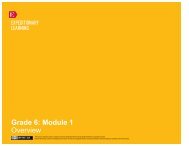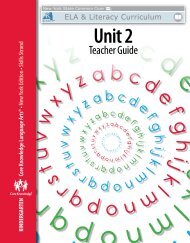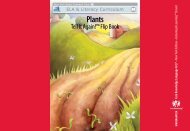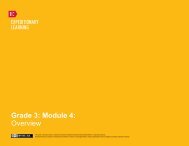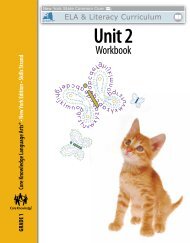Skills Unit 2 Teacher Guide - EngageNY
Skills Unit 2 Teacher Guide - EngageNY
Skills Unit 2 Teacher Guide - EngageNY
You also want an ePaper? Increase the reach of your titles
YUMPU automatically turns print PDFs into web optimized ePapers that Google loves.
Presenting the Student’s Draft<br />
• Display the student’s draft.<br />
• If permitted by the student, identify the author and invite the student to<br />
present his or her book report by reading it out loud. (If the student has not<br />
agreed to be identified, you may read the draft.)<br />
• Ask the class to give the author a round of applause: “Let’s hear it for our<br />
author!”<br />
• Explain that you would like students to begin by telling the author something<br />
they liked about his or her book report. Model this for the class.<br />
• Invite other students to say something they liked about the book report. Write<br />
down these positive comments on the board, or on a separate piece of chart<br />
paper.<br />
Editing the Student’s Draft<br />
• Have students open to Worksheet 13.1. Tell students this is an editing checklist.<br />
They will use it to edit the chosen author’s draft. The checklist identifies areas<br />
the author might want to think about to make his or her book report better.<br />
• Make clear that the entire class is using the editing checklist to edit one<br />
student’s work today. In the future, students will each be expected to use the<br />
checklist to edit their own work.<br />
• Ask the class if the draft has a title. If so, have students make a check mark<br />
next to the question on the editing checklist. The title can still be added or<br />
changed at this point.<br />
• Complete the remaining questions and discuss whether the item can be<br />
checked—or whether improvements could be made. Model making any<br />
changes to the draft that the class has agreed would be changes for the<br />
better.<br />
• Use the following editing conventions when correcting the draft. Explicitly call<br />
students’ attention to these conventions, explaining this is how professional<br />
writers edit their work. Explain they will use these very same conventions<br />
when they edit their own work:<br />
• Cross out punctuation mistakes and write the correct punctuation mark<br />
above the wrong one.<br />
• Cross out capitalization mistakes and write the correct<br />
uppercase/lowercase letter above the wrong one.<br />
• Write a carat (^) where a word or punctuation mark needs to be inserted.<br />
Write the word or punctuation mark above the carat.<br />
• Correct spelling mistakes if students notice or question them. You<br />
should accept phonemically possible spellings for spellings students<br />
have not yet learned.<br />
<strong>Unit</strong> 2 | Lesson 13 119<br />
© 2013 Core Knowledge Foundation



